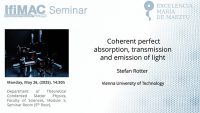Title: Shaking magnons: active and passive role of acoustic phonons in quantum magnonics
When: Tuesday, June 3, 2025, 12:00
Place: Department of Theoretical Condensed Matter Physics, Faculty of Sciences, Module 5, Seminar Room (5th Floor)
Speaker: Carlos Gonzaález Ballesteros / Institute for Theoretical Physics, Vienna University of Technology (TU Wien)
Spin waves, namely magnetization waves propagating in magnetic materials, have risen in the last decades as promising information carries in future information processing devices [1]. This is due to their low loss compared to electronic currents and their exotic combination of properties which are difficult to find elsewhere: for instance, dynamical frequency tunability, high nonlinearity, and the ability to couple effectively to multiple degrees of freedom, from microwave and optical photons to spin qubits or acoustic phonons. Coincidentally, these same properties make spin waves and their quanta (magnons) potential assets as components of hybrid quantum systems. The nascent field of Quantum Magnonics aims at exploring this potential [2]. Despite few experiments in single-mode magnonic resonators [3,4], it remains unknown what kind of propagating quantum states can be prepared in general structures nor how long can they preserve quantum coherence, as spin waves are much lossier than e.g. photons and current detectors are not sensitive to the small fields of few-magnon states. In this talk I will present our work exploring both fronts with the aid of an auxiliary degree of freedom: acoustic phonons. I will show how magnetoelastic interaction in the strong coupling regime, which has been recently demonstrated [5], enables controlled excitation of parametric instabilities resulting in the onset of magnon parametric down-conversion which has both lower threshold and higher selectivity selectivity of output modes than conventional magnon-magnon processes. This paves the way toward the controlled preparation of highly occupied Gaussian entangled states which could be certified with current detection methods. I will also discuss our theoretical derivation of phonon-induced magnon decoherence from the fundamental magnetoelastic Hamiltonian, which goes beyond current effective models and thus allows us to quantitatively set the limits of quantum state preparation in magnonic systems. [1] AV Chumak et al, “Advances in magnetics roadmap on spin-wave computing”, IEEE Transactions on Magnetics 58, 1 (2022) [2] D. Lachance-Quirion et al, “Hybrid quantum systems based on magnonics”, Applied Physics Express 12, 070101 (2019) [3] Lachance-Quirion et al, “Entanglement-based single-shot detection of a single magnon with a superconducting qubit”, Science 367, 425 (2020) [4] Xu et al, ” Quantum Control of a Single Magnon in a Macroscopic Spin System”, PRL 130, 193603 (2023) [5] Y Hwang, J Puebla, K Kondou, C Gonzalez-Ballestero, et al, “Strongly coupled spin waves and surface acoustic waves at room temperature”, Phys. Rev. Letters 132, 056704 (2024)






